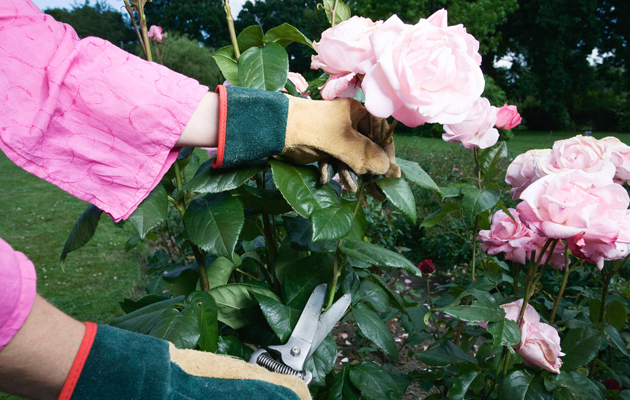How to prune roses
Alan Titchmarsh tackles the thorny issue of pruning roses.


At this time of year, I develop a love/hate relationship with the climbing roses on our house. Some time ago, in this column, I confessed that, for the previous five years or so, I had encouraged our local tree surgeon to simply trim them back with his hedge trimmer in autumn, to leave 6in stems all over. For the first few years, the results were encouraging.
The two days it normally takes me to do the job had been reduced to a couple of hours of someone else’s labours and the scratches and cuts that my face and arms normally endured were a thing of the past. What’s more, the roses themselves seemed little the worse for this cavalier approach and their flowering was unaffected.
Now, however, the roses are looking in need of more drastic action. The moment has come for an overhaul.
You need: loppers, secateurs and optimism. A methodical approach also makes life easier.
- Out comes anything obviously dead brown, crisp stems are a giveaway. Dead wood on roses is notoriously hard, so make sure your loppers are sharp and use them rather than secateurs for any stems that are as thick or thicker than your finger. Cut dead wood back almost flush with the living stem, so as not to leave stubs, which can host fungus diseases.
- A proportion of older ‘live’ wood needs to be removed, too. Many climbing and rambling roses have thick and gnarled stems that are giving rise to younger ones. These can stay, as they’re fulfilling a useful role, but aim to reduce their number, so that younger wood is allowed space the younger, vigorous stems will produce more in the way of flowers.
- Weak and overcrowding stems come next, along with any showing signs of disease mildew, rust or (on remaining leaves) black spot. It’s worth gathering up the fallen leaves from the base of the bush and burning them to prevent disease spores being at large to infect next year’s growth.
- What I look for on my climbers and ramblers (and I make no distinction between the two here) is a good framework of young and vigorous stems that can be spaced out and tied into the horizontal wires that are placed up the wall at 18in intervals. I’ll be aiming to get good coverage, while still allowing 1ft or so between the stems when they’re tied in. All the stems will be shortened at the tips so that they can be fitted into the space available and any sideshoots will be cut back to finger length.
- Stout, plastic-coated wire is ideal to hold the larger stems in place; smaller ones are easier to wrangle with Flexi-Tie, a plastic ‘twine’ that’s enormously useful, as it’s strong, pliable and long-lasting.
- Shrub roses in beds and borders will be pruned at the same time and on roughly the same principle: cutting out dead, diseased, weak and crossing stems and then gently cutting back the tips to reduce wind rock and improve overall shape.
Sign up for the Country Life Newsletter
Exquisite houses, the beauty of Nature, and how to get the most from your life, straight to your inbox.
Country Life is unlike any other magazine: the only glossy weekly on the newsstand and the only magazine that has been guest-edited by HRH The King not once, but twice. It is a celebration of modern rural life and all its diverse joys and pleasures — that was first published in Queen Victoria's Diamond Jubilee year. Our eclectic mixture of witty and informative content — from the most up-to-date property news and commentary and a coveted glimpse inside some of the UK's best houses and gardens, to gardening, the arts and interior design, written by experts in their field — still cannot be found in print or online, anywhere else.
-
 Five Cotswold dream homes on the market from £3m to £18m, as seen in Country Life
Five Cotswold dream homes on the market from £3m to £18m, as seen in Country LifeThis week we have a Cotswolds-themed rundown of some of the finest homes to come to the market in this beautiful part of England.
-
 Here Today, Gone Tomorrow: 'Nature’s ephemeral beauty reminds us of our own finite existence'
Here Today, Gone Tomorrow: 'Nature’s ephemeral beauty reminds us of our own finite existence'A withering rosebud, the brevity of blossom and the one-day wonder of the mayfly: Nature’s ephemeral beauty reminds us of our own finite existence, but melancholy transience also offers moments of magic.